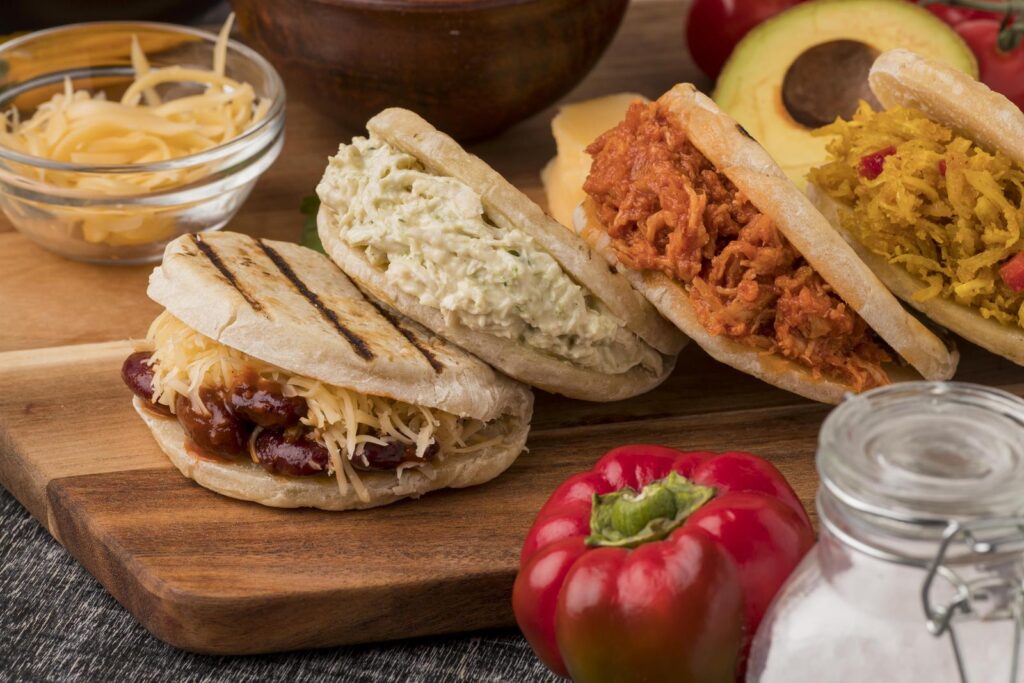If you’ve ever tasted an arepa, you know it’s a delicious and versatile staple of Latin American cuisine. But how did this humble cornmeal cake become integral to the region’s food culture? Explore the history of the arepa and how it became the beloved dish it is today.

Arepa origins
The arepa has been a part of Latin American cuisine for centuries, but its origins can be traced back to the indigenous tribes of what is now Venezuela and Colombia. These tribes used cornmeal to make a flatbread called “cachapa,” similar to the arepa we know today.
As European colonizers arrived in South America, they brought wheat flour and other ingredients that began influencing the local cuisine. However, the arepa remained a popular food among the indigenous people and eventually became a staple in the region.
Evolution over time
Over time, different countries and regions developed unique variations of the arepa. In traditional Colombian food, arepas are often stuffed with cheese or meat and served with a side of avocado. In Venezuela, they are served plain or with various fillings such as shredded beef, black beans or cheese.
Today, the arepa has become a ubiquitous dish throughout Latin America and is enjoyed by people of all backgrounds. It’s a meal and a symbol of the region’s rich culinary history and cultural heritage.

Arepa versions
There are many ways to prepare this beloved staple of Latin American cuisine.
The most traditional Colombian arepas are made with precooked corn meal, called masarepa. These corn cake arepas are typically had for breakfast with nothing but butter.
To take them to the next level, these round and flattened cakes can be filled with various ingredients, such as cheese, called “arepas con queso”, avocado or meat. Venezuelan arepas are usually stuffed and eaten for lunch or dinner.
Another popular version is plantain cakes or plantain arepas, made with mashed plantains instead of cornmeal. These arepas have a sweeter taste, and they can be enjoyed plain or filled with different ingredients like cheese or shrimp.
“Arepas de choclo” is yet another type of arepa, and this time it is made with sweet corn. The kernels are ground to create the masa, which gives the arepas a sweet and grainy texture different from the other types.
Arepas make a delicious and versatile meal any time of day, and they are gluten free and easy to make.
How to make corn flour arepas
To make basic corn flour arepas, you will need three ingredients: a cup of pre-cooked corn flour, a cup of water and a pinch of salt.
Mix the flour and salt in a bowl, and slowly pour in the water until it forms a dough. Knead the dough for a few minutes until it is smooth and pliable. Then, divide the dough into small balls and flatten them into thick patties, about ½-inch thick.
Heat a nonstick pan over medium heat, and cook the arepas for about four minutes on each side, until they are golden brown and cooked through. Keep the arepas in the oven until you are ready to serve them.
You can now slice your arepas open and fill them with a variety of savory or sweet ingredients, such as cheese, ham, avocado, chicken or dulce de leche.

To wrap up
The arepa may have started as a simple flatbread, but it has evolved into an essential part of Latin American cuisine. Its versatility, deliciousness and cultural significance have made it a beloved dish in the region and beyond. So the next time you take a bite of an arepa, remember the rich history and tradition behind this iconic Latin American staple.
Ksenia Prints is a food writer, blogger, photographer and recipe developer from Montreal, Canada. She blogs over At the Immigrant’s Table, a food blog showcasing healthy, beautiful international recipes for adventurous home cooks. She loves to highlight ethnic cuisines and immigrant cultures by working with chefs from relevant countries, and to adapt those recipes to gluten free, vegan, vegetarian, sugar free and other dietary restrictions.
This article originally appeared on Food Drink Life.